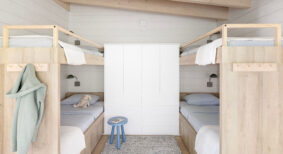Following the model of the 2010 National Building Code of Canada, the newest version of the British Columbia Building Code has introduced a new occupancy classification.
In previous editions of the code, the Group B Division 2 (B2) occupancy classification included both treatment and care types of health care. The new Group B Division 3 (B3) care classification addresses occupancies such as assisted living and other managed health care that does not include acute treatment. The acute treatment type of building use (for example, a hospital) is still classified as B2 occupancy.
The B3 occupancy, by definition, includes a facility where services are provided to support cognitive, physical or behavioural limitations. It includes assisted living facilities, hospices (without treatment), respite centres, facilities for Alzheimer’s and dementia patients, and child care facilities for very young children. The need for these facilities has increased in the past several years as the general population has aged.
While there is definitely a need to provide life safety for the occupants of B3 facilities, the need is not as extensive as that required for a B2 hospital. In a B2 facility, occupants may be impaired to the extent that they are incapable of self-preservation (mobility limitations), and the code requirements that govern fire and life safety reflect this. However, occupants of a B3 facility may need help getting out of a building under emergency conditions but are generally able to do so under their own power. So, the B2 requirements are generally too onerous for the B3 occupancy. On the other hand, the code requirements for a Group C residential occupancy (C) are not sufficient to address the life safety needs of the B3 occupancy. The result is that the B3 code provisions are effectively a hybrid between the B2 and C requirements.
Key features of the new B3 occupancy include:
- Buildings must be protected with fire sprinklers;
- A three-quarter hour or one hour suite separation fire-resistance rating;
- Smoke alarms are required in bedrooms and suites;
- A maximum of six metre dead end common corridors are permitted,
- Floors must be carved up into maximum 1,000 square metre fire compartments with a one hour fires-resistance rating;
- Corridors are a minimum of 1,650 millimetres in width, if there is no patient movement in beds;
- Doors must provide 850 millimetres of clear, unobstructed width;
- An 18.4 millimeters per person exit capacity factor; and
- Single stage fire alarm system is permitted for a building not exceeding three-storeys; otherwise, a two stage fire alarm system is required.
From a design perspective, the new B3 classification allows (for the first time) combustible construction in a three-storey building and increases the area limits for a combustible two-storey building. If the building height or area are larger than that allowed, then the building has to be of noncombustible construction.
The increased allowances for combustible construction will give rise to conversions of smaller combustible buildings into updated facilities for B3 use – an option that had limited possibilities under the previous edition of the B.C. Building Code.
Randall Kovacs is president of Gage-Babcock & Associates Ltd. The company provides building code, fire protection engineering and security consulting services throughout Canada. Randall can be reached at r_kovacs@gbacan.com.







